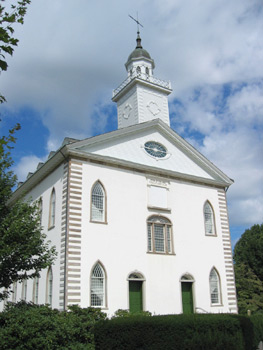


Come visit Historic Kirtland, a small settlement in northern Ohio where members of The Church of Jesus Christ of Latter-day Saints gathered shortly after the Church was founded. Between 1831 and 1838, Joseph Smith and early members of the Church established Church headquarters in Kirtland, built a temple*, and laid a foundation of strength for the future. Other nearby historic sites:
- The Kirtland Ashery
- Isaac Morley Farm
- John Johnson Home
- Johnson Inn Resource Center
- Newel K. Whitney Store
- Newel K. and Elizabeth Ann Whitney Home
- Kirtland Sawmill
- Kirtland Schoolhouse
- Kirtland Temple Stone Quarry
Kirtland Ashery


Gain insight into this unique industry and the importance of the Kirtland Ashery in providing the financial means to build the temple and other Church buildings.
Newel K. Whitney Store
Visit the Newel K. Whitney general store, restored to its 1830
condition. Joseph Smith lived here for a time and established the School
of the Prophets in one of the upper rooms.
Newel K. and Elizabeth Ann Whitney Home
Kirtland Schoolhouse
Kirtland Temple Stone Quarry

Kirtland Temple

“Why doesn’t The Church of Jesus Christ of Latter-day Saints own the Kirtland Temple?” many LDS Church members wonder this as they tour the Kirtland, Ohio, historic sites. Both LDS Church and Community of Christ members have learned to work together with one another in a spirit of cooperation fostered by a joint love of the history and holiness of the Kirtland Temple.
David J. Howlett, a professor of
The Prophet Joseph Smith and early members of the church built the Kirtland Temple and it was dedicated in March 1836 (see Doctrine and Covenants 109 and 100). Ownership changed due to conflicts within Ohio and Missouri, pinacling after the martydom of Joseph Smith in 1844, as various leaders with claims to the church tried to take control of the temple, igniting many legal battles that lasted through much of the late 19th century.
By 1901, the Reorganized Church of Jesus Christ of
Latter Day Saints (now Community of Christ) legally secured ownership
and has worked to preserve the temple for the benefit of those connected
to the history and heritage of Mormonism
Temple Locale
Temple Facts
- The Kirtland Temple was the first temple erected in this dispensation.
- The School of the Prophets, a forerunner to temple worship, was established three years before the dedication of the Kirtland Temple. The school met in a room above the Newel K. Whitney Store.
- The early Saints referred to the Kirtland Temple as simply the "Lord's House," as the term temple was not in general use at the time.
- Log construction was proposed for the Kirtland Temple in early discussions.
- The design for the Kirtland Temple was received by detailed revelation to the Prophet Joseph Smith and others. The temple included a lower hall for worship and an upper hall for education. Both featured pulpits on either end with initials representing priesthood offices.
- During construction, the Kirtland Temple was guarded at night to protect the building from threatening mobs and vandals.
- The Saints crushed glass and chinaware into the stucco applied to the exterior walls of the Kirtland Temple, which glittered in the sun.
- During the weeks surrounding the dedication of the Kirtland Temple, the Saints experienced an outpouring of heavenly manifestations, which included the appearance of angels and the Saints seeing visions, uttering prophecies, and speaking in tongues.
- On Easter Sunday, April 3, 1836, during the Jewish Passover, the Lord appeared to Joseph Smith and Oliver Cowdery in the Kirtland Temple, accepting His house. Priesthood keys were then restored through three ancient prophets: Moses, the keys to the gathering of Israel; Elias, the dispensation of the gospel of Abraham; and Elijah, the sealing keys.
- The ordinances received in the Kirtland Temple were only a partial endowment. The full endowment would not be received until the Saints settled in Nauvoo.
- Two years after the dedication of the Kirtland Temple, the Saints had largely abandoned Kirtland, and the temple became the venue of both private worship and public function. For a short time, the upper floors hosted a variety of public events while the basement was used to keep farm animals. The temple was later leased for many years as a public school.
- In 1880, the Community of Christ reestablished ownership of the Kirtland Temple, and the building was restored as closely as possible to its original condition.









No comments:
Post a Comment